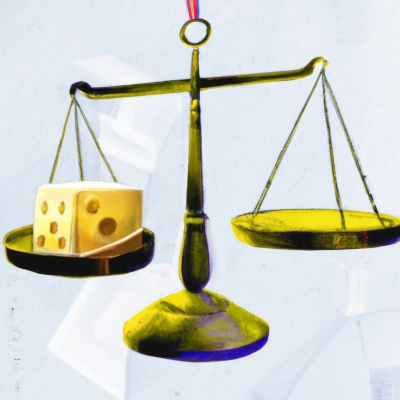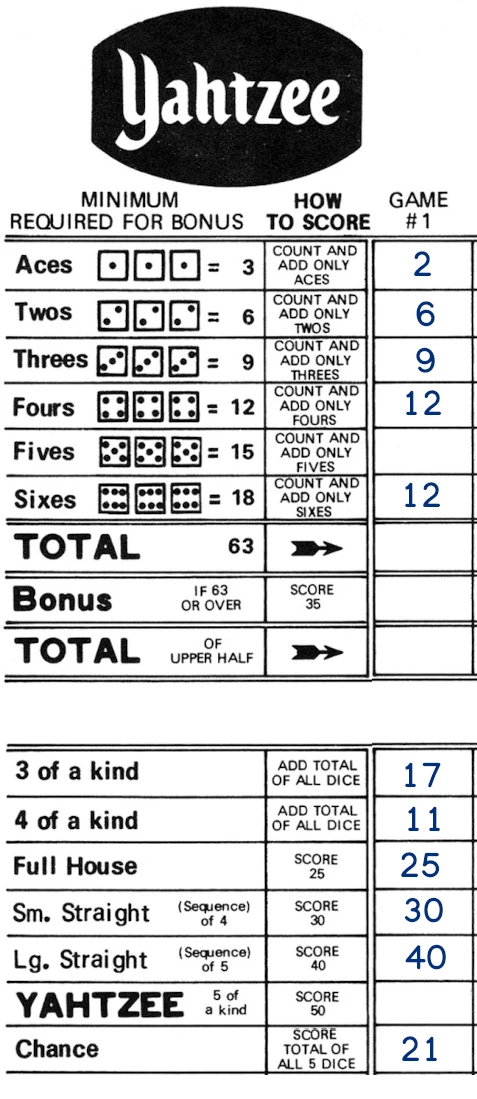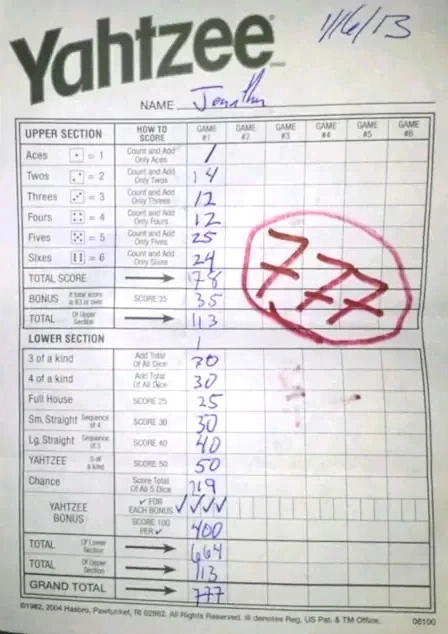Joker Gambit: Strategic Sacrifice in Yahtzee
The Yahtzee scoring category is the game's namesake and the only path to sky-high scores. The 100-point Yahtzee Bonus and potential Jokers are jet fuel for your grand totals. But does it ever make sense to roll a Yahtzee and pass it up? The Joker's Gambit is the most famous dilemma in Yahtzee strategy, tempting a player to sacrifice the Yahtzee and end up increasing their total score.

In a game of Yahtzee, decision-making skills are crucial to success. Each roll of the dice presents players with a set of options and opportunities, and it is up to the player to decide which combination of dice to keep, which to re-roll, and ultimately, which score to choose from the Yahtzee scorecard. A player who makes informed and strategic decisions will have a better chance of achieving a high score and winning the game. Additionally, the ability to make quick and confident decisions can give a player a psychological edge over their opponents, further increasing their chances of success.
But Yahtzee is oftentimes a game of tough decisions with an angel on one shoulder and a devil on the other, each whispering sweet temptations directly into your cerebral cortex. Decision-making needs to be precise, so interpreting those competing strategic voices should be a top priority during any Yahtzee match. A solid understanding of the game’s underlying mathematics principles, including probabilities and Yahtzee odds, is a necessity in developing a sound strategy. But the advanced player will also probe deeper into the tactical advantages that can flow from a properly executed gambit.
Understanding Yahtzee Gambits

A gambit in Yahtzee represents a calculated risk, deliberately sacrificing immediate scoring opportunities to secure greater rewards later in the game. This strategic approach involves forgoing certain points now to create a stronger position for later turns, much like sacrificing material in chess to gain positional advantage or tempo.
In chess, the Queen's Gambit (1. d4 d5 2. c4) exemplifies this principle perfectly. White offers a pawn that Black can capture, but doing so gives White control of the center and accelerated development. Similarly, in Yahtzee, zeroing out a Three of a Kind that would score only 8 points might preserve your chance at a 40-point Large Straight or potential Yahtzee.
What unites gambits across games is their fundamental philosophy: short-term sacrifice for long-term gain. In chess, you might sacrifice a pawn; in Go, the tenuki move abandons an immediate local battle; and in Yahtzee, you forfeit modest scoring opportunities — all pursuing a strategic horizon beyond the immediate turn.
The difference between novice and expert Yahtzee players often lies in understanding when these sacrifices make mathematical sense versus when they represent wishful thinking. Much as a chess master knows exactly when material sacrifice yields sufficient compensation, the Yahtzee expert calculates probability paths that justify passing on immediate points.
The Psychology of Sacrifice
What makes gambits fascinating is the psychological dimension they add to Yahtzee. Each decision carries weight beyond simple probability - it's about timing, risk tolerance, and sometimes even psychological warfare against opponents. When you choose to zero out a category that might have earned modest points, you're making a statement about your confidence in future rolls.
The chess parallel continues here as psychological pressure is a key element in both games. When a chess player sacrifices material and continues playing aggressively, it creates doubt in the opponent's mind: "Do they see something I'm missing?" Similarly, bold Yahtzee gambits can unsettle opponents, making them second-guess their own conservative play.
This psychological edge becomes most apparent in multi-player Yahtzee, where opponents watch your decisions and may adjust their strategies accordingly. A player who regularly employs gambits becomes unpredictable, forcing others to consider a wider range of possible strategies and potentially pulling them away from their optimal play. The resulting uncertainty, much like facing an unconventional chess opening, often leads to mistakes that the gambit player can capitalize on.
However, it's crucial to recognize a fundamental difference: while chess is fundamentally a game where you directly play against your opponent, Yahtzee's primary battle is against probability and your own decision-making. The dice are inherently indifferent to psychological tactics, making psychological gambits a secondary strategy that should never overshadow sound probabilistic play.
Common Yahtzee Gambits
The Conservative Approach: Playing the Odds
Most casual players adopt what might be called "playing the odds", a conservative approach where difficult scoring categories are zeroed out early when poor rolls occur. This strategy aims to:
- Minimize damage from bad luck
- Reserve easier categories for future turns
- Ensure consistent, if modest, scoring
While statistically sound, this approach rarely produces extraordinary scorecard totals. It's reliable but unambitious - prioritizing a clean, straightforward approach to the game rather than a pursuit of tricky gambits. The path of a player who prioritizes consistency over spectacular results.
The Yahtzee Hunter's Gambit

For those pursuing glory, the Yahtzee Hunter's Gambit represents a bolder path. This approach takes deadly aim at the game's namesake while willingly sacrificing:
- Low-scoring opportunities
- Sometimes entire sections of the scorecard
- Most definitely the Full House
- Even the 35-point Upper Section bonus
All in pursuit of the game-changing Yahtzee and its potential for additional bonus scores. This high-risk strategy can transform a mediocre game into a record-breaking performance - or end in spectacular failure. Such single-minded focus is a dubious strategy but it most certainly opens the door for serious points. With this gambit, the it's always open season for the Yahtzee.
The Upper Section Sacrifice
One of the most controversial gambits involves deliberately surrendering the Upper Section bonus. By zeroing out categories like Ones, Twos, or Threes early, players free themselves to pursue more lucrative combinations. The 35-point bonus becomes expendable when weighed against the potential for multiple Yahtzees or a strong Lower Section.
The Second-Choice Strategy
Play the opponent with this psychological gambit, designed to manipulate fellow rollers rather than simply maximize one's own score. This subtle approach involves deliberately selecting your second-best scoring option instead of the obvious choice. By consistently making unexpected yet still reasonable decisions, you create several advantages:
- Opponents struggle to predict your strategy
- You maintain flexibility in your scorecard
- You create confusion about which categories you're targeting
When executed properly, this approach can disrupt opponents' planning while preserving your own strategic options.
The Joker's Gambit: The Ultimate Strategic Sacrifice

the Joker's Gambit
The Joker's Gambit stands as the pinnacle of strategic sacrifice in Yahtzee strategy. Named after the Yahtzee Joker Rules that govern scoring multiple Yahtzees, this gambit embodies the trickster spirit of its namesake - unpredictable, powerful, and sometimes chaotic.
What makes the Joker's Gambit so remarkable is its paradoxical nature: deliberately foregoing an already rolled Yahtzee, normally the game's most coveted combination. This counterintuitive decision challenges the fundamental assumption that a bird in hand is worth two in the bush.
The Classic Scenario
Consider this high-stakes situation: You've reached the endgame with only two turns remaining. Your scorecard shows both the Yahtzee box and Fives category still open. The 35-point Upper Section bonus appears out of reach - you would need to score 25 points in Fives (requiring all five dice showing fives) to cross the 63-point threshold.
Then, against all odds, you roll a Yahtzee in Fives! Five identical dice showing five pips each.
The conventional wisdom screams to mark this as a Yahtzee for a guaranteed 50 points. However, the calculating player recognizes a potential alternative: scoring this roll as 25 points in Fives would secure the 35-point Upper Section bonus, totaling 60 points - a 10-point advantage over the standard Yahtzee score.
The Calculation of Risk
The Joker's Gambit hinges on your assessment of risk versus reward. The conservative approach secures 60 points immediately by taking the Fives and claiming the bonus. The aggressive play - the true gambit - involves:
- Scoring the roll as a Yahtzee (50 points)
- Positioning yourself for a potential second Yahtzee on your final turn
- If successful, claiming not only the standard score for that category but also the 100-point Yahtzee Bonus
This spectacular payoff would dramatically outweigh the foregone Upper Section bonus. However, the probability of rolling a second consecutive Yahtzee is exceedingly slim - approximately 1 in 1,296 with optimal reroll strategy.
The Joker's Gambit exemplifies the essence of high-level Yahtzee play: understanding when mathematical expectation justifies seemingly irrational choices. It transforms the game from simple dice rolling into a complex decision tree where psychological fortitude becomes as important as statistical knowledge.
Executing the Joker's Gambit requires mastering Yahtzee's nuanced rules, especially the Yahtzee Bonus and Joker provisos which allow scoring multiple Yahtzees in the game. It showcases a willingness to eschew guaranteed points for a legendary, high-scoring finale. Only the most daring dice mavens can pull off such a deliciously devious feat against all odds.
Gambits inject unique strategic quandaries into every Yahtzee game. Coupled with statistical savvy, these situations can propel your skills to the next level and secure more wins.




